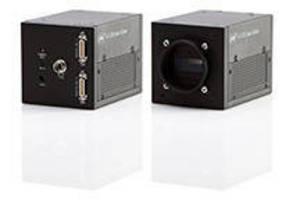Color Line Scan Camera features prism-based 4-CCD design.
Press Release Summary:

Featuring beam splitter prism with hard dichroic coatings, Model LQ-200CL captures red, green, blue, and NIR light spectrum bands simultaneously in 4 separate channels through same optical path. Each CCD sensor provides 2,048 linear pixels with pixel size of 14 µm x 14 µm square. Running at max scan rate of 19,048 lines/sec with 40 MHz pixel clock, camera delivers SNR of 58 dB. Pre-processing functions include flat-field correction, gamma/gain correction, and manual/automatic white balance.
Original Press Release:
JAI Introduces Prism-Based 4-CCD Color Line Scan Camera
Provides simultaneous separate imaging of R, G, B plus NIR light
SAN JOSE, CA - JAI has announced the release of the LQ-200CL - a new prism-based 4-CCD color line scan camera providing simultaneous separate imaging of red, green, and blue, plus near-infrared light data.
The camera, which is one of the only industrial-grade 4-CCD line scan cameras on the market, features a beam splitter prism with hard dichroic coatings incorporating four precisely pixel-to-pixel aligned CCD sensors. R, G, B and NIR light spectrum bands are captured simultaneously in four separate channels through the same optical path. By adding an NIR sensor, the new camera makes it possible to identify an even wider range of defects on inspected objects.
Each of the four CCD sensors provides 2048 linear pixels with a pixel size of 14 µm x 14 µm square. The camera runs at a maximum scan rate of 19048 lines per second with a 40 MHz pixel clock, delivering a high signal-to-noise ratio of 58dB.
The camera's prism-block technology enables users to avoid the complex alignment and encoding issues associated with tri-linear line scan cameras, especially those related to off-axis viewing, variations in conveyor speeds, surface undulations, or objects that roll or move as they pass through the camera's field of view.
A number of built-in pre-processing functions are available including flat-field correction, gamma/gain correction and manual/automatic white balance. With the gamma/gain correction function the user can take full advantage of the sensors' dynamic range to optimize the image. Gamma/gain correction, flat-field correction, as well as the electronic shutter can be set individually for the red, blue, green and NIR channels.
With a special noise reduction circuit and a newly developed algorithm, the LQ-200CL makes it possible to improve the signal-to-noise ratio by up to 3 dB (depending on the situation) without losing spatial resolution.
The LQ-200CL features three shutter operating modes, including a pulse width control mode, providing users with substantial flexibility in operating the camera. The camera outputs 4 x 8 bits or 4 x 10 bits through a Camera Link interface. A binning function can combine the values of two adjacent pixels at the output stage resulting in double sensor sensitivity.
A test pattern generator is also included that can be applied as a set-up and installation aid to check the performance of the camera. This feature also provides users with help when debugging and setting up the frame grabber.
Just like JAI's other line scan cameras, the LQ-200 undergoes extensive shock and vibration testing to maximize its ability to withstand the rigors of industrial environments. Specifications include 50G shock testing and 3G vibration testing. A ridged housing design provides maximum surface area for heat dissipation resulting in excellent temperature management and optimal image quality.
LQ-200CL is available with M52 mount (standard) or Nikon F-mount (optional).
About the JAI Group
JAI is a manufacturer of high quality, industrial-grade cameras for the machine vision, transportation, aerospace, homeland security, medical and scientific markets.
JAI's broad product line features high performance progressive scan CCD cameras with spatial resolutions from VGA to 16 megapixels; traditional interlaced video cameras; intensified cameras with sensitivity to light levels as low as .00001 lux, and a range of innovative 2CCD and 3CCD prism-block cameras including both area scan and line scan models.
Physical interfaces include the Camera Link® and GigE Vision® high performance digital standards, as well as both TV-standard and analog progressive scan output.
JAI cameras help improve customer businesses in a variety of ways, whether by improving quality and accuracy, lowering costs, increasing yields, or simply enabling better service. In addition to cameras, JAI's traffic solutions group is one of the world's leading manufacturers of specialized traffic systems. Solutions are based on JAI-developed hardware and software, which is often integrated with third-party products.




